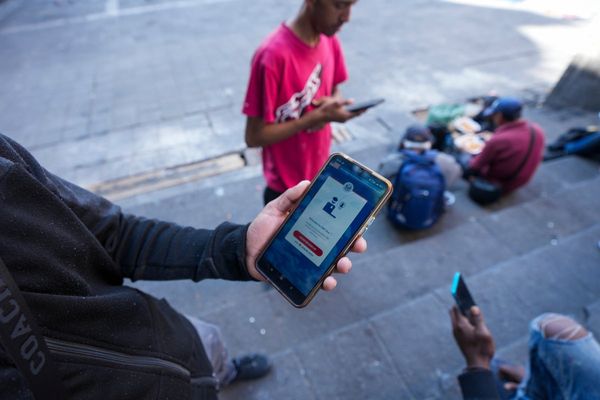President Donald Trump failed to accomplish much with the China-focused trade war in his first term. While the U.S. trade deficit with China has shrunk modestly, America's overall trade gap has grown. Now he's pulling out the heavy artillery and taking Trump tariffs global.
The so-called reciprocal tariffs unveiled Wednesday, which Trump billed as a "Liberation Day" that will buoy U.S. manufacturers, were far more aggressive than just about anyone on Wall Street expected. Clearly, investors don't share Trump's positive view of tariffs. The news triggered a stock market rout, sending the S&P 500 tumbling back into correction territory.
China's retaliatory tariffs Friday signaled the trade war could intensify.
Trump Outdoes The Worst Case Scenario
The effective tariff rate had already jumped to 8.5% from 2.3% in 2024, when Fitch Ratings warned two weeks ago that reciprocal tariffs could push the tariff rate toward 18%. Admittedly, that potentially looked "too harsh," Fitch said, as Wall Street still held out hope that Trump's threats would prove mostly a negotiating ploy.
Yet that hope has been crushed over the past two weeks. First Trump let fly with 25% tariffs on autos — even those in compliance with his 2019 U.S.-Mexico-Canada Agreement — having twice stepped back from that precipice. Reciprocal tariffs — as high as 54% on China and 46% on Vietnam — pushed the effective U.S. tariff rate to 25%, Fitch estimates.
The impact of Trump tariffs will take time to show up in real U.S. economic data, but the forward-looking stock market has buckled. The S&P 500 has tumbled more than 15% from its Feb. 19 record high and is now at 11-month lows. Even Trump administration officials acknowledge there will be short-term pain. The question is how much pain and whether there will be a long-term gain.
Trump's Great Wall Of Protectionism
Trump is erecting a wall of protectionism unlike anything seen since the 1930s in his bid to fortify the U.S. industrial base and raise trillions in tariff revenue.
Abrupt trade shifts forced by Trump tariffs are certain to cause some whiplash, denting economic growth and further driving up the inflation rate that remains stuck above the Federal Reserve's 2% target. That means stagflation, characterized by sluggish economic growth and high inflation, at least in the near term. Yet Trump's full-scale trade war is not guaranteed to deliver any better results than the 2018-19 conflict that now seems a mere skirmish in comparison.
Tariffs aren't just expected to weigh on American consumers, but to price U.S. exporters out of overseas business. Reversing lopsided trade that Trump characterizes as "theft" also risks reversing the flow of foreign money to the U.S. Those flows have helped underpin the dollar's status as the world's reserve currency, financing gaping federal budget deficits and fueling stock market returns far beyond those of overseas markets.
Trump Tariffs: Not Just 'A Negotiating Tactic'
In announcing that 25% auto tariffs would take effect April 3, Trump last week for the first time dismissed any possibility of negotiation. "This," he declared, "is permanent."
Those words delivered a jolt to General Motors and Ford Motor, and turned back a stock market rally. GM stock suffered a three-day loss of 10.1%. Ford, with more domestic production, had a more-muted decline. Even steel prices, propped up by new 25% tariffs, have taken a dive.
Until now, Wall Street firms believed that a stock market correction could prompt a Trump tariff course adjustment. In February and again in early March, Trump suspended his move to essentially blow up the U.S.-Mexico-Canada Free Trade Agreement. But now reality is sinking in.
"While we previously thought tariffs were mainly a negotiating tactic to achieve other policy objectives (e.g., border security, fentanyl), we now believe the administration wants to facilitate structural change via re-shoring," Deutsche Bank analyst Edison Yu wrote on March 27.
Yu noted that the U.S. imported 7.2 million vehicles last year, or 45% of total sales, while exporting just 1.3 million. "The imbalances have simply gotten too wide to close using conventional measures," Yu wrote.
The belief that the Trump tariffs are permanent is crucial to their success. If firms believe the levies may be removed at a moment's notice, "the chances that new tariffs unlock a wave of investment in domestic manufacturing are remote," wrote Samuel Tombs, chief U.S. economist at Pantheon Macroeconomics, on March 18.
These Are The Best Growth Stocks To Buy And Watch
Trading Uncertainty For Certainty
Abrupt, aggressive action by Trump could avoid dragging out the uncertainty that has depressed business confidence and paralyzed long-term investment decisions. Yet the downside of certainty is that the economy is about to hit a major speed bump.
Federal Reserve Chairman Jerome Powell noted in his March 19 news conference that business and consumer surveys, so-called soft data, are flashing "downside risks." However, "The real economy, the hard data, are still in reasonably good shape."
Yet the hard data reflects a record surge in imports, a boost in manufacturing and a bump in sales as businesses and consumers raced to front-run the Trump tariffs. That tailwind has kept the economy on an upward path despite uncertainty.
Once pre-tariff inventories are depleted, vehicle prices will adjust upward by 10% or more, wrote Jonathan Smoke, chief economist at Cox Automotive.
"After an initial, short surge in buying, we expect vehicle sales to fall, new and used (vehicle) prices to increase, and some models to be eliminated if tariffs persist," Smoke wrote.
As Trump aims to rev up U.S. auto factories, higher prices may initially have the reverse effect. Last week, even as Trump announced auto tariffs, Cleveland-Cliffs, one of the major suppliers of steel to the auto industry, announced 600 layoffs in Dearborn, Mich., citing "the current reality of weak automotive production."
Trump Tariff Rout: Nasdaq In Bear Market
Trump Tariffs: Flexible And Permanent
"Everyone knows Mr. Trump likes to do deals," Pantheon's Tombs wrote. Yet Wall Street is figuring out that there's not necessarily a contradiction between permanent and negotiable in the Trump trade war 2.0. Increasingly, Trump is drawing a line between country-focused reciprocal tariffs that may be subject to dealmaking and permanent tariffs focused on industries he sees as key to national security, such as industrial metals, and those countries with which the U.S. has enormous trade deficits.
Besides 25% auto tariffs, Trump has hit steel and aluminum imports with 25% tariffs. He has signaled plans to do the same for imports of copper, pharmaceuticals and semiconductors.
The U.S. trade deficit in autos, parts and engines ($305 billion), and pharmaceuticals ($139 billion) accounted for nearly 40% of the $1.2 trillion goods deficit in 2024, Commerce Department data shows.
The official trade gap in semiconductors came to just $17 billion last year. However, that excludes most semiconductor imports already embedded in products such as servers, laptops and Apple iPhones.
Treasury Secretary Scott Bessent had said that "reciprocal" tariffs would focus on the "dirty 15" — the 15% of partners that run a big trade surplus with the U.S.
Likely targets include China ($295 billion surplus), the European Union ($236 billion), Mexico ($172 billion), Vietnam ($123.5 billion), Taiwan ($74 billion), Japan ($68.5 billion), South Korea ($66 billion), Canada ($63 billion), India ($46 billion), Thailand ($46 billion), Switzerland ($38.5 billion) and Malaysia ($25 billion).
Reciprocal Tariff Surprises
Yet the sweeping tariffs revealed by Trump on Wednesday were wider and higher than expected. The "reciprocal" tariffs aren't actually based off other countries' trade surpluses. So, imports from China will face a 30% tariff rate, on top of the 20% tariff imposed earlier this year.
Vietnamese goods face a 46% tariff rate; Taiwan and Indonesia 32%; India 27%; South Korea 25%; Japan 24% and the European Union 20%.
Even the U.K., which runs a bilateral trade deficit with the U.S., will face a 10% tariff.
That means Apple iPhones produced for the U.S. market in China would face a 54% tariff. Apple iPhones produced for the U.S. in India would face a 26% reciprocal tariff. Trump has hinted at some tariff relief for China if there's a deal that keeps TikTok operating in the U.S.
The fine print of President Trump's executive order indicates that "reciprocal" tariffs won't apply to autos, semiconductors, steel, aluminum, copper and other products already targeted or potentially still to be targeted by sectoral tariffs. That means Taiwan Semiconductor chips produced in Taiwan for the U.S. market won't face a 32% tax. However, Trump has previously said he wants to apply a 25% tax on chips. There had been concern that "reciprocal" tariffs would stack on top of sectoral tariffs.
Another positive surprise: The White House left Canada and Mexico off the "reciprocal" tariff list. On top of that, the White House fact sheet indicated that 25% tariffs imposed on a wide swath of imports from Mexico and Canada could fall to 12% if they address Trump's fentanyl and migration concerns.
Trade Retaliation
How damaging Trump's trade war will be for the U.S. economy will depend partly on trading partners' retaliation, which could compound tariffs' self-inflicted damage to U.S. exporters.
On Friday, China hiked tariffs on all U.S. goods by 34%. Earlier in the year, Beijing imposed only modest duties on targeted U.S. goods following Trump's initial tariff hikes.
Will other countries follow suit?
The European Union had temporarily shelved retaliatory measures for 25% Trump tariffs on steel and aluminum that kicked in on March 12.
"The EU raised the white flag even before the battle commenced," the Eurointelligence consultancy wrote on March 21. "What happened is that France and Italy got scared at Donald Trump's threat to tariff EU wine imports at 200%."
The European Union's move to de-escalate makes sense, the political risk group said, given its $236 billion goods trade surplus with the U.S.
European Commission President Ursula von der Leyen said Tuesday, however, that the EU's strength is "built on our readiness to take firm countermeasures." Politico reported that the EU may target major U.S. banks or technology services firms. The U.S. has a large, high-margin surplus in services with Europe and the world.
Germany and France, the two largest EU economies, have signaled a desire to strike back, following Trump's "reciprocal" tariffs.
Longer term, other countries may seek to shift trade away from the U.S., as China did somewhat after Trump's tariffs in his first term.
Welcoming A U.S. Economic Downturn?
On March 30, Goldman Sachs economists revised down their U.S. GDP growth outlook for 2025 to just 1% from 1.5%, and pushed up their unemployment forecast to 4.5% from 4.2%. Yet that forecast assumed a 15 percentage point increase in the effective tariff rate this year, well below the roughly 22.5 percentage point increase estimated by Fitch.
Goldman said its downbeat economic forecast also reflected "statements from White House officials indicating greater willingness to tolerate near-term economic weakness in pursuit of their policies."
Trump may see more to gain than lose from a sharp slowdown, which could compel the Fed to lower interest rates and pressure the narrow Republican majority in Congress to pass a massive package of tax cuts and spending curbs.
The 10-year Treasury yield tumbled to a five-month low 4.05% on Thursday, lowering borrowing costs for consumers — and the federal government.
Join IBD experts as they analyze leading stocks and the market on IBD Live
The Curse Of 'Cheap Goods'
The new Trump trade war is really a war on the global trading system itself.
"Access to cheap goods is not the essence of the American dream," Treasury Secretary Scott Bessent said in a March 6 speech at the Economic Club of New York.
The policy of "let them eat flat screens" as an alternative to good-paying factory jobs hasn't served the American middle class, Bessent told the All-In Podcast on March 19.
Bessent's critique of the global trading system connects the huge U.S. trade deficit with massive federal government deficits. The two deficits are, to a significant extent, opposite sides of the same coin.
Michael Pettis, nonresident fellow at the Carnegie Endowment for International Peace, has explained that the U.S., as the top-consuming nation with minimal trade barriers or capital controls, absorbs much of the world's excess production. Countries such as Germany and especially China, which ran a $1 trillion trade surplus last year, pursue "beggar-thy-neighbor" policies. They subsidize their export sectors at the expense of their own domestic consumption, he says.
At the same time, U.S. overspending on foreign goods has been enabled by other countries that overproduce and spend their excess savings to acquire American assets such as equities and bonds. The result, Pettis says, has been "the decline of American manufacturing" and depressed U.S. savings rates. Those trends in turn are associated with "an ever-growing fiscal deficit."
Bessent told the All-In Podcast that the trade-off has worked out well for Wall Street, while Main Street has suffered. "I think it's Main Street's time," he said.
Trump Tariffs: Right Diagnosis, Wrong Prescription?
Pettis' diagnosis of global trading system ills has gained influence. Free-trade purists have become a rare species. Yet economists generally view tariffs as, at best, a blunt instrument for curing those ills. At worst, tariffs can be counterproductive, making protected industries less efficient while doing little to reverse trade imbalances.
A 2019 study on the impact of the 2018-19 trade war by Fed economists Aaron Flaaen and Justin Pierce found that a small boost in manufacturing employment thanks to Trump tariffs was "more than offset by larger drags from the effects of rising input costs and retaliatory tariffs."
In general, economists expect reduced imports to strengthen the dollar. That would further diminish the competitiveness of U.S. exporters, negating any benefit from tariffs. That's what happened during the 2018-19 trade war, JP Morgan Asset Management market strategists Gabriela Santos and Marina Valentini noted recently. The U.S. dollar index rose 10% in 2018 and 4% in 2019. A weaker Chinese currency "partially cushioned the impact of tariffs by making Chinese exports relatively cheaper and preserving their competitiveness in the global market."
Peter Morici, a University of Maryland economist focused on trade, wrote in a recent MarketWatch column that Trump's trade policies are inconsistent with geopolitical goals. "Big tariffs on Canada, Mexico, Europe, Japan and others will weaken those economies, encourage retaliation against the U.S. and drive these reliable U.S. allies into accommodations with Russia and China," he said.
That risk appears even more real after recent news that Japan and South Korea will hold trade talks with China. China hopes to drive a wedge between the U.S. and those two allies, which play a key role in blocking Beijing's access to advanced chip technology.
Used Cars Love Tariffs. So Do Auto Parts Stocks.
Subsidies Vs. Tariffs
In a recent Foreign Affairs piece, Chad Brown, senior fellow at the Peterson Institute for International Economics, and Dartmouth economics professor Douglas Irwin also questioned whether tariffs aimed at boosting manufacturing jobs can really bolster the middle class. They noted that a $20 billion semiconductor factory "operates using few workers, aside from highly trained engineers."
President Joe Biden sought to revive U.S. manufacturing in a few key areas, including semiconductors, electric vehicles and alternative energy, through hundreds of billions of dollars in CHIPS Act and Inflation Reduction Act subsidies. The approach delivered results, as spending on new manufacturing facilities nearly tripled from $81 billion in 2019 to $233 billion in 2024.
Yet Trump and Bessent aim to save U.S. manufacturing with tariffs, not subsidies. Bessent argues that the U.S. economy needs a "detox" to avert a fiscal crisis after excessive fiscal deficits.
Peter Navarro, senior White House trade adviser, told Fox News that the Trump tariffs could raise $6 trillion over a decade, or $600 billion a year. That would equal 1.9% of GDP in 2025. That would make Trump's tariffs the biggest tax hike by that measure since World War II, according to Tax Foundation data. Actual tariff revenue, though, would fall far short as the tax hike slows the economy and hammers imports.
Most tariff revenue is expected to go toward renewing 2017 tax cuts and passing new ones later this year.
Time The Market With IBD's ETF Market Strategy
Trump Tariffs And The Stock Market
Every five percentage point increase in the U.S. tariff rate cuts S&P 500 earnings per share by 1%-2%, Goldman Sachs chief U.S. equity strategist David Kostin estimates. This year's estimated 22.5 percentage point increase implies a potential 4.5%-9% cut in S&P 500 earnings from Trump tariffs. Kostin cut his 2025 S&P 500 target to 5,700 ahead of "Liberation Day."
That implies a 3.1% S&P 500 decline for the year, but that may understate the stock market volatility ahead. Despite a boost to inflation as firms pass through some portion of tariffs to customers, the economic hit will likely prompt the Fed to resume rate cuts. That would precede tax cuts, which could give the economy a shot in the arm to start 2026.
Volatility also could come if Trump's America First fiscal, trade and defense policies hit the brakes on — or conceivably reverse — the flow of foreign money into U.S. capital markets. The U.S. net international investment position sank to -$26.2 trillion at the end of 2024. That's how much more foreigners hold in U.S. financial assets than overseas positions held by Americans.
Those investment flows have been drawn to the U.S. due to a combination of better growth, stronger productivity, higher interest rates, technology leadership, military might, Federal Reserve credibility and the dollar's supremacy. When the global economy hits turbulence, the dollar and U.S. Treasurys have been the ultimate safe havens.
'Stay Home' Vs. 'Go Global'
Yet now tariffs and DOGE have the U.S. economy at risk of stalling, while Trump is going his own way on foreign policy, leaving Europe to rearm and control its own fate. Meanwhile, Germany and China are stepping on the fiscal accelerator as they meet the hit from Trump tariffs head-on.
"This raises the potential of capital repatriation on multiple fronts that could become very disorderly," wrote Joseph Wang, chief investment officer of MonetaryMacro.com.
Still, tax cuts, deregulation and a potential AI-driven productivity boom are around the corner. Plus, it's still possible that Trump alters course. Until markets go into a tailspin and the 10-year Treasury gets caught in the downdraft, it's too soon to write off American exceptionalism.
Market strategist Ed Yardeni has cut his S&P 500 target to 6,100 from 6,400 with Trump "so willing to take a wrecking ball to the economy." But that still points to a recovery by year-end. Yardeni wrote in a note before Wednesday's tariff escalation that he was sticking with his "Stay Home" vs. "Go Global" investment bias. He argues that a U.S. recession would infect Europe too, while China demographics and deleveraging are reminiscent of Japan's lost decades.







